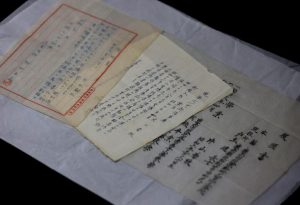Documenting Hiroshima of 1945: In December, 17-year-old unable to send out job resume
Dec. 18, 2024
by Minami Yamashita, Staff Writer
In December 1945, Kikue Katayama, 17 at the time, who was from the area of Hatsukaichi-cho (in present-day Hatsukaichi City) in Hiroshima Prefecture, was confined to bed. Ms. Katayama had been engaged in relief work for the wounded on Kanawajima Island (in Hiroshima City’s present-day Minami Ward) for slightly more than one month after the atomic bombing, becoming ill as a result. Motivated to “get a job upon getting well to help my family,” she had been writing up her job resume.
Her resume listed the years of her entrance into and graduation from Danbara Jinjo Higher Elementary School (present-day Danbara Elementary School, in Hiroshima’s Minami Ward) and Hiroshima Girls’ Commercial School (present-day Hiroshima Shoyo High School). She also included in the resume her history of mobilization in the Japanese Imperial Army’s Shipping Command as a member of the Women’s Volunteer Corps.
Ms. Katayama experienced the atomic bombing on August 6 in the area of Ujina-cho (in Hiroshima’s Minami Ward). Soon after the bombing, she had been dispatched to Kanawajima Island, on the shore opposite from Ujina and, until September 10, engaged in the care of the wounded who were being brought to the island. Her younger brother, Atsumu Katayama, who died in 2014 at the age of 83, responded to an interview at the Hiroshima Peace Memorial Museum in 2005, when he donated Kikue’s resume and other items to the museum. “My sister was working so hard she couldn’t get much sleep. She was exhausted when she finally left the corps,” said Atsumu.
Their family home, located in the area of Danbara (in Hiroshima’s present-day Minami Ward), had collapsed in the bombing and, with that, she moved to Hatsukaichi-cho with her parents and younger brothers. At the end of 1945, she is thought to have been bedridden. However, she was still a kind sister who cared about her younger brother, saying to him, “I’ll buy you something when I start working.”
At the beginning of the next year, a physician examined her, but the diagnosis ended up being “uncertain cause.” She suffered from bleeding of the nose and gums and, on May 19, 1946, she died at the age of 18. The cause of her death was diagnosed as “acute pneumonia.” Her resume remained in the hands of her family.
Losing his only daughter, her father attempted to prove she had died from her relief work. He located her supervisor from that time, who wrote for Mr. Katayama a certificate stating, “Upon military order, she worked to treat the atomic bomb survivors inside an air-raid shelter on Kanawajima Island, regardless of whether it was daytime or night, until she was discharged on September 10.” Her mother would pull out from the family’s Buddhist altar a notebook in which Kikue, who was talented at drawing, had created flip animations and sketched animals, to gaze at and continue to mourn.
(Originally published on December 18, 2024)
In December 1945, Kikue Katayama, 17 at the time, who was from the area of Hatsukaichi-cho (in present-day Hatsukaichi City) in Hiroshima Prefecture, was confined to bed. Ms. Katayama had been engaged in relief work for the wounded on Kanawajima Island (in Hiroshima City’s present-day Minami Ward) for slightly more than one month after the atomic bombing, becoming ill as a result. Motivated to “get a job upon getting well to help my family,” she had been writing up her job resume.
Her resume listed the years of her entrance into and graduation from Danbara Jinjo Higher Elementary School (present-day Danbara Elementary School, in Hiroshima’s Minami Ward) and Hiroshima Girls’ Commercial School (present-day Hiroshima Shoyo High School). She also included in the resume her history of mobilization in the Japanese Imperial Army’s Shipping Command as a member of the Women’s Volunteer Corps.
Ms. Katayama experienced the atomic bombing on August 6 in the area of Ujina-cho (in Hiroshima’s Minami Ward). Soon after the bombing, she had been dispatched to Kanawajima Island, on the shore opposite from Ujina and, until September 10, engaged in the care of the wounded who were being brought to the island. Her younger brother, Atsumu Katayama, who died in 2014 at the age of 83, responded to an interview at the Hiroshima Peace Memorial Museum in 2005, when he donated Kikue’s resume and other items to the museum. “My sister was working so hard she couldn’t get much sleep. She was exhausted when she finally left the corps,” said Atsumu.
Their family home, located in the area of Danbara (in Hiroshima’s present-day Minami Ward), had collapsed in the bombing and, with that, she moved to Hatsukaichi-cho with her parents and younger brothers. At the end of 1945, she is thought to have been bedridden. However, she was still a kind sister who cared about her younger brother, saying to him, “I’ll buy you something when I start working.”
At the beginning of the next year, a physician examined her, but the diagnosis ended up being “uncertain cause.” She suffered from bleeding of the nose and gums and, on May 19, 1946, she died at the age of 18. The cause of her death was diagnosed as “acute pneumonia.” Her resume remained in the hands of her family.
Losing his only daughter, her father attempted to prove she had died from her relief work. He located her supervisor from that time, who wrote for Mr. Katayama a certificate stating, “Upon military order, she worked to treat the atomic bomb survivors inside an air-raid shelter on Kanawajima Island, regardless of whether it was daytime or night, until she was discharged on September 10.” Her mother would pull out from the family’s Buddhist altar a notebook in which Kikue, who was talented at drawing, had created flip animations and sketched animals, to gaze at and continue to mourn.
(Originally published on December 18, 2024)








